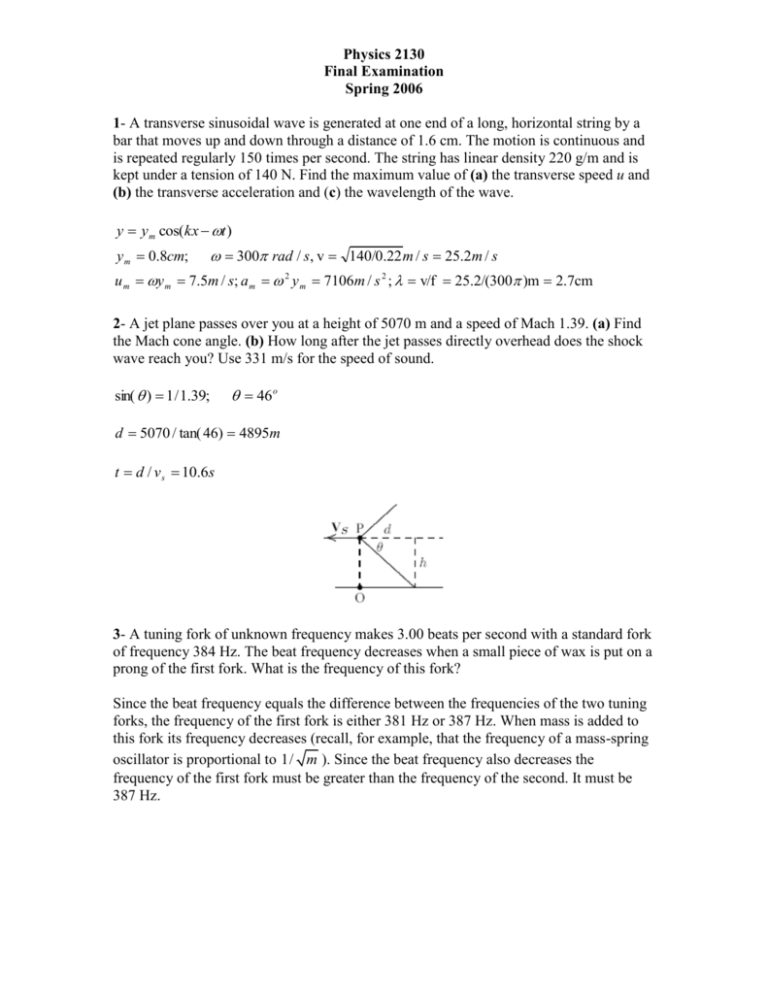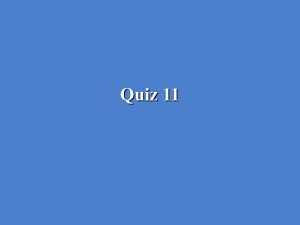samp-final-sol
advertisement

Physics 2130 Final Examination Spring 2006 1- A transverse sinusoidal wave is generated at one end of a long, horizontal string by a bar that moves up and down through a distance of 1.6 cm. The motion is continuous and is repeated regularly 150 times per second. The string has linear density 220 g/m and is kept under a tension of 140 N. Find the maximum value of (a) the transverse speed u and (b) the transverse acceleration and (c) the wavelength of the wave. y y m cos(kx t ) y m 0.8cm; 300 rad / s, v 140/0.22 m / s 25.2m / s u m y m 7.5m / s; a m 2 y m 7106m / s 2 ; v/f 25.2/(300 )m 2.7cm 2- A jet plane passes over you at a height of 5070 m and a speed of Mach 1.39. (a) Find the Mach cone angle. (b) How long after the jet passes directly overhead does the shock wave reach you? Use 331 m/s for the speed of sound. sin( ) 1 / 1.39; 46 o d 5070 / tan( 46) 4895m t d / v s 10.6s 3- A tuning fork of unknown frequency makes 3.00 beats per second with a standard fork of frequency 384 Hz. The beat frequency decreases when a small piece of wax is put on a prong of the first fork. What is the frequency of this fork? Since the beat frequency equals the difference between the frequencies of the two tuning forks, the frequency of the first fork is either 381 Hz or 387 Hz. When mass is added to this fork its frequency decreases (recall, for example, that the frequency of a mass-spring oscillator is proportional to 1/ m ). Since the beat frequency also decreases the frequency of the first fork must be greater than the frequency of the second. It must be 387 Hz. Physics 2130 Final Examination Spring 2006 4- The maximum electric field 10 m from an isotropic point source of light is 2.0 V/m. What are (a) the maximum value of the magnetic field and (b) the average intensity of the light there? (c) What is the power of the source? (a) The magnetic field amplitude of the wave is Bm Em 2.0 V / m 6.7 109 T. 8 c 2.998 10 m / s (b) The intensity is b g hc 2 2.0 V / m E2 I m 5.3 103 W / m2 . 7 8 2 0c 2 4 10 T m / A 2.998 10 m / s c h (c) The power of the source is P 4r 2 I avg 4 10m 5.3 103 W/m2 6.7 W. 2 5- Unpolarized light is sent into a system of two polarizing sheets. The angles θ1 and θ2 of the polarizing directions of the sheets are measured counterclockwise from the positive direction of the y axis (they are not drawn to scale in the figure). Angle θ1 is fixed but angle θ2 can be varied. Figure below gives the intensity of the light emerging from sheet 2 as a function of θ2. (The scale of the intensity axis is not indicated.) What percentage of the light's initial intensity is transmitted by the two-sheet system when θ2 = 90°? 36 Physics 2130 Final Examination Spring 2006 We examine the point where the graph reaches zero: 2 = 160º. Since the polarizers must be “crossed” for the intensity to vanish, then 1 = 160º – 90º = 70º. Now we consider the case 2 = 90º (which is hard to judge from the graph). Since 1 is still equal to 70º, then the angle between the polarizers is now =20º. Accounting for the “automatic” reduction (by a factor of one-half) whenever unpolarized light passes 1 through any polarizing sheet, then our result is 2 cos2() = 0.442 44%. 6- A 2.00-m-long vertical pole extends from the bottom of a swimming pool to a point 50.0 cm above the water. Sunlight is incident at angle θ = 55.0°. What is the length of the shadow of the pole on the level bottom of the pool? nwater=**** 49 Consider a ray that grazes the top of the pole, as shown in the diagram that follows. . m. The length of the shadow is x + L. Here 1 = 90° – = 35°, 1 0.50 m, and 2 150 x is given by x 1 tan 1 (0.50 m) tan 35 0.35 m. According to the law of refraction, n2 sin 2 = n1 sin 1. We take n1 = 1 and n2 = 1.33 (from Table 33-1). Then, 2 sin 1 F sin I Fsin 35.0IJ 2555 sin G G J K . . . Hn K H133 1 2 1 Physics 2130 Final Examination Spring 2006 L is given by L 2 tan 2 (150 . m) tan 25.55 0.72 m. The length of the shadow is 0.35 m + 0.72 m = 1.07 m. 7- A sand grain is 3.00 cm from thin lens 1, on the central axis through the two symmetric lenses. The distance between focal point and lens is 4.00 cm for both lenses; the lenses are separated by 8.00 cm. (a) What is the distance between lens 2 and the image it produces of the sand grain? Is that image (b) to the left or right of lens 2, (c) real or virtual, and (d) inverted relative to the sand grain or not inverted? 133 (a) Our first step is to form the image from the first lens. With p1 = 3.00 cm and f1 = +4.00 cm, Eq. 34-9 leads to 1 1 1 i1 12.0cm. p1 i1 f1 The corresponding magnification is m1 = –i1/p1 = 4. This image serves the role of “object” for the second lens, with p2 = 8.00 + 12.0 = 20.0 cm, and f2 = –4.00 cm. Now, Eq. 34-9 leads to 1 1 1 i2 3.33 cm . p2 i2 f 2 (b) The fact that i2 is negative means that the final image is virtual (and therefore to the left of the second lens). (c) The image is virtual. (d) With m2 = –i2/p2 = 1/6, the net magnification is m = m1m2 = 2/3 > 0. The fact that m is positive means that the orientation of the final image is the same as the (original) object. Therefore, the image is not inverted. Physics 2130 Final Examination Spring 2006 8- A broad beam of light of wavelength 683 nm is sent directly downward through the top plate of a pair of glass plates. The plates are 120 mm long, touch at the left end, and are separated by 48.0 mm at the right end. The air between the plates acts as a thin film. How many bright fringes will be seen by an observer looking down through the top plate? 69 Consider the interference of waves reflected from the top and bottom surfaces of the air film. The wave reflected from the upper surface does not change phase on reflection but the wave reflected from the bottom surface changes phase by rad. At a place where the thickness of the air film is L, the condition for fully constructive interference is 2 L m 21 where (= 683 nm) is the wavelength and m is an integer. This is satisfied for m = 140: b g bm g b140.5gc683 10 mh 4.80 10 L 9 1 2 5 2 m = 0.048 mm. At the thin end of the air film, there is a bright fringe. It is associated with m = 0. There are, therefore, 140 bright fringes in all. 9- (a) In a double-slit experiment, what ratio of d to a causes diffraction to eliminate the fourth bright side fringe? (b) What other bright fringes are also eliminated? 31 (a) In a manner similar to that discussed in Sample Problem 36-5, d sin( ) 4 a sin( ) 1, we find the ratio should be d/a = 4. Our reasoning is, briefly, as follows: we let the location of the fourth bright fringe coincide with the first minimum of diffraction pattern, and then set sin = 4/d = /a (so d = 4a). (b) Any bright fringe which happens to be at the same location with a diffraction minimum will vanish. Thus, if we let sin = m1/d = m2/a = m1/4a, or m1 = 4m2 where m2 1, 2, 3, . The fringes missing are the 4th, 8th, 12th, and so on. Hence, every fourth fringe is missing. Physics 2130 Final Examination Spring 2006 10- Show that if a spherical refracting surface with an index of refraction n2 placed in a medium with an index of refraction n1 the following expression holds: Here p is the object distance, i is the image distance and r is the radius of the spherical refracting surface. Assume rays make small angles with the central axis of the surface. See page 945 (derivation of eq 34-8) 11- Standing waves are produced by the interference of two traveling sinusoidal waves, each of frequency 100 Hz. The distance from the 2nd node to the 5th node is 60 cm. The wavelength of each of the two original waves is: (5 2) / 2 60 50 cm 40 cm 30 cm 20 cm 15 cm 12- A 40-cm long string, with one end clamped and the other free to move transversely, is vibrating in its fundamental standing wave mode. If the wave speed is 320 cm/s the frequency is: 4(40)cm 160cm f v / 2 Hz 32 Hz 16 Hz 8 Hz 4 Hz 2 Hz 13- If the sound level is increased by 10 db the intensity increases by a factor of: log( I ) I0 2 1 10 log( I2 I ) log( 1 ) 10 I0 I0 10 log( I2 / I0 ) log( I 2 / I 1 ) I 2 / I 1 1010 I1 / I 0 Physics 2130 Final Examination Spring 2006 2 5 10 20 100 14- Two pipes are each open at one end and closed at the other. Pipe A has length L and pipe B has length 2L. Which harmonic of pipe B matches in frequency the fundamental of pipe A? f v / 2 Hz f A v /( 4 L) f B nv /(8L) n 1,3,5... The second The third There are none The fourth The fundamental 14- Light of uniform intensity shines perpendicularly on a totally absorbing surface, fully illuminating the surface. If the area of the surface is decreased: pr I / c Fr p r A 1- the radiation pressure decreases and the radiation force decreases 2- the radiation pressure increases and the radiation force decreases 3- the radiation pressure increases and the radiation force increases 4- the radiation pressure stays the same and the radiation force increases 5- the radiation pressure stays the same and the radiation force decreases Physics 2130 Final Examination Spring 2006 15- The index of refraction of benzene is 1.80. The critical angle for total internal reflection, at a benzene-air interface, is about: sin( ) 1 / 1.8 1- 56° 2- 47° 3- 34° 4- 22° 5- 18° 16- An erect object is placed on the central axis of a thin lens, further from the lens than the magnitude of its focal length. The magnification is +0.4. This means: 1- the image is virtual and erect, and the lens is a diverging lens 2- the image is real and inverted and the lens is a converging lens 3- the image is virtual and erect, and the lens is a converging lens 4- the image is virtual and inverted and the lens is a diverging lens 5- the image is real and erect and the lens is a converging lens 17- The bellows of an adjustable camera can be extended so that the largest film to lens distance is one and one-half times the focal length. If the focal length is 12 cm, the nearest object which can be sharply focused on the film must be what distance from the lens? 1 1 1 p 36cm 18 p 12 1- 12 cm 2- 24 cm 3- 36 cm 4- 48 cm 5- 72 cm Physics 2130 Final Examination Spring 2006 18- In a Young's double-slit experiment, a thin sheet of mica is placed over one of the two slits. As a result, the center of the fringe pattern (on the screen) shifts by an amount corresponding to 30 dark bands. The wavelength of the light in this experiment is 480 nm and the index of the mica is 1.60. The mica thickness is: L N 2 N1 n2 n1 L 30 (480 10 6 mm) 1.6 1 1- 0.090 mm 2- 0.012 mm 3- 0.014 mm 4- 0.024 mm 5- 0.062 mm 19- Waves from two slits are in phase at the slits and travel to a distant screen to produce the third side maximum of the interference pattern. The difference in the distance traveled by the waves is: L d sin( ) n n 0,1,2,3... For the third maximum L 2 1- half a wavelength 2- a wavelength 3- three halves of a wavelength 4- two wavelengths 5- five halves of a wavelength 20- Monochromatic light is normally incident on a diffraction grating that is 1 cm wide and has 10,000 slits. The first order line is deviated at a 30° angle. What is the wavelength, in nm, of the incident light? d sin( ) n n 0,1,2,3... 0.01m (0.5) 500nm 10000 1- 300 2- 400 3- 500 Physics 2130 Final Examination Spring 2006 4- 600 5- 1000








